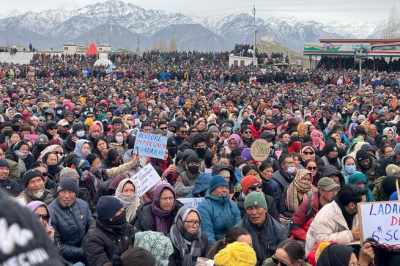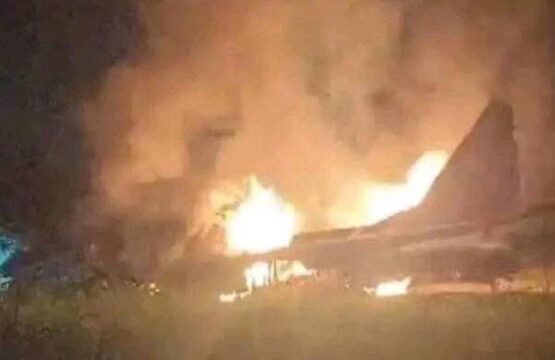The recent protests in Ladakh involved over 30,000 people gathered to demand their rights. Sonam Wangchuk, an educator and activist, decided to go on a hunger strike until the government heard their voices. He emphasizes that the issues in Ladakh are due to political and corporate influences.
The demands of the people in Ladakh include constitutional representation, statehood, adequate parliamentary representation, and secure job opportunities, highlighting the environmental vulnerabilities and the need to protect their democratic rights post the abrogation of Article 370.
The protests began in 2020 when the Indian Army clashed with the Ladakh people, and the Home Minister met with representatives from both sides. However, the meeting resulted in no resolution, and tensions escalated. The protests gained momentum due to the demand for a Sixth Schedule and the Second Inner Line Permit.
The meeting was held under the Indian government, and representatives from both sides, including a CARICOM Lotus Officer and a representative from the Muslim community, were present. The Ladakh region, which is located in the northern part of
India, has been under Indian occupation since the 1962 war. The region is also home to various ethnic groups, and the issue of autonomy and representation is a significant concern for many. The protests gained international attention when Article 370 and Article 35a were revoked, which granted special status to Jammu and Kashmir. This move divided the province into two Union territories, and many saw it as a violation of historical rights.
Sonam Wangchuk discusses the political situation in Ladakh following the revocation of its special status in 2019. The residents of Ladakh are isolated, and due to this, they face a lack of essential services such as education, healthcare, and employment opportunities. The population is also affected by water scarcity, human settlements, and frost migration.
Additionally, corporate influence, such as the exploration of oil and gas and military waste and armament dumb, had severely impacted the climate, which is why the people of Ladakh are facing climate change, leading to water crises and agricultural issues.
Also Read: Cold War 2.0: Proxy War in the Red Sea
Wangchuk mentions that the people are used to carrying five litres of water per day and that the lack of pipelines and sewage treatment systems is a problem. The electricity problem in this region is another issue, with power peaks leading to load shedding and impacting daily life. He also mentions that Ladakh’s land and resources, including farming and mining, are crucial to the region’s people and that they fear losing control over them.
The land in question is significant to the local people and contains unique ecosystems and rare minerals. The corporations, such as those involved in mining, are opening up these lands, which could negatively affect the environment and local communities. The Indian government is prioritizing corporate interests over protecting these valuable resources.
The locals are demanding the implementation of the Sixth Schedule, which would grant them more autonomy and elected councils to address their concerns. Sonam Wangchuk, a local leader, has proposed a local innovation model for ITPA (Indira Gandhi Paryavaran Odhikaran) states, including J&K and Northeast India, to ensure that development projects do not affect local communities and their customary rights.
The Ladakh Hill Council and the Autonomous Bodies under Article 371 have more powers and special privileges, including the power to make laws and levy taxes. However, these privileges come with challenges, such as natural resource demands from Ladakh residents, water scarcity, and border disputes with China.
After the revocation of Article 370, the people of Jammu and Ladakh were initially hopeful, as the BJP had made promises for development. However, since 2019, there has been little to no progress in development, and people are facing prejudice at the commercial level.
The people of Jammu and Ladakh are protesting against the BJP due to the Ladakh Autonomous Hill Development Council (LAHDC) Leh, where people rejected the BJP’s radical Hindutva agenda. This was further evident in the Ladakh elections, where the ruling BJP could only secure two seats out of twenty-six (26).
The People of IIOJK had an emotional connection with Article 370. Even those who celebrated its abrogation are now mourning its absence. This challenges the BJP’s claims that people are supportive of India and that the situation in IIOJK is normal. The people of Ladakh said no to the BJP’s Sectarian agenda and hate politics.
The BJP lured the people of IIOJK with fake promises of development and prosperity after the revocation of Article 370. After Article 370 was removed, the BJP started exploiting local ethnic and sectarian fault lines. However, four years have passed since the revocation, and nothing has changed on the ground except for the use of brute force and witch-hunting of intellectuals and even any dissenting voice. This fact forced the Hindus of Jammu as well to protest against Modi and the Indian government.
***Authors Muhammad Shahzad Akram and Saba Ghulam Nabi are Research Officers at Center for International Strategic Studies, AJK









